Knowledge of science in the world varies from nation to nation, and prior to the Hundred Year War, most people relied on pre-industrial levels of technology, with the Fire Nation being the major exception. In the years following the conflict, scientific and technological advancement increased exponentially and became more widespread. Medicinal curatives were developed to compensate for the lack of Water Tribe healers.[1] Later on, Republic City in particular, emerged as a leading pioneer in the field, hosting many industries whose products are shipped around the world.
Despite this rapid development, some areas of science are still somewhat limited. Some prominent people in the field include the mechanist,[2] the Satos, and Varrick.
Air Nomads[]
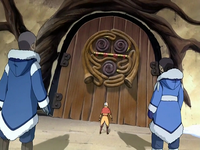
The door to the Southern Air Temple's sanctuary is an example of the Air Nomads' scientific knowledge.
From what is known of Air Nomad history, they did not have many scientific breakthroughs or technological advancements, and the pieces of technology they did possess relied heavily on airbending to operate. The Air Nomads also designed an extensive collection of building plans during their travels to other nations.[1]
Architecture[]
All the cultures of the known world have outstanding examples of building construction. The Air Nomads' temples are made of finely-worked stone and often situated on remote mountaintops. Most curious of all is the Western Air Temple, whose pagodas are anchored from an overhanging cliff and appears upside down to casual observers.[3] The Northern Air Temple is more than 4,000 years old, having existed—at least in some form—during the lifetime of Guru Laghima.[4]
Both the Southern and Northern Air Temples have sanctuaries within the structures. The doors to these rooms are sealed with an elaborate locking mechanism that can only be opened through the use of airbending or machinery mimicking the bending art.[2][5]
Environmental science[]
The Air Nomads have a great understanding of the natural world and try to cause as little environmental damage as possible. This awareness of human effects on the environment is a defining trait of Air Nomad culture, and it is strongly linked to their general cultural beliefs about non-violence. The Air Nomads also have enough technical expertise to produce items like their gliders,[6] which cause no pollution due to being operated by airbending and natural air currents, and are thus environmentally friendly modes of transportation.
Philosophy[]
While not science in the strictest sense of the word, the Air Nomads have well-developed philosophical notions about the world and humanity's place in it. Their beliefs in compassion, non-violence, and respect for all life essentially form the core components of their culture. They also have an understanding of how people's emotions can affect their overall mental state, as well as their relationship to others and the world around them. Overall, the Air Nomads have stronger spiritual beliefs than the other nations, which tends to draw them away from technological developments.
The Air Acolytes, who continue to practice the Air Nomads' traditions, also generally draw away from science, despite the fact that they live in an age of developing scientific and technological advancements. Nonetheless, they are more connected to the outside world than their Nomad predecessors, as evidenced by Jinora's understanding of the inner workings of a radio,[7] as well as a radio being kept in the Northern Air Temple for easier communication.
Water Tribe[]
Due to the Fire Nation's frequent raids during the Hundred Year War, the Southern Water Tribe experienced little growth in science or technology during that period. The Northern Water Tribe had a far greater level of advancement for many areas, most notably in architecture, but overall the scientific knowledge of both tribes was relatively primitive compared to that of the Earth Kingdom or the Fire Nation. Despite being located within the Earth Kingdom, the Foggy Swamp Tribe was essentially isolated from surrounding peoples, and likewise possessed a very primitive level of technology. By Avatar Korra's time, both of the polar tribes had advanced significantly in science and technology, in part as a result of increased contact with each other and the outside world at large.
Astronomy[]
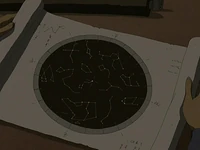
Katara used a star chart to navigate the Si Wong Desert.
The Water Tribes have always had a strong cultural association with the moon, and their stories say that waterbending itself was first taught to humans by the moon. Although grounded more in spirituality than actual science, this association has influenced certain scientific aspects of their culture. The phases of the moon have a significant effect on the strength of waterbending: a waxing moon steadily enhances a bender's strength, a full moon brings it to a peak, and a waning moon slowly reduces that strength. Lunar eclipses can also temporarily eliminate a bender's abilities altogether. The tribes have always known how the moon affects the ocean's tides, and as skilled sailors and navigators, the tides play a major role in how they travel. The stars also play a significant factor in the tribes' navigational abilities, allowing them to navigate even foreign territory.[8]
Engineering[]
Due to the watery nature of their homelands, the tribes are skilled in building various types of ships to navigate the surrounding seas, ranging from small fishing canoes for short-range travel and food-gathering expeditions[6] to larger warships and merchant vessels to cover long distances.[9]
During the final year of the Hundred Year War, Sokka designed a unique waterbending-powered submarine that was used during the invasion of the Fire Nation.[10]
Geography[]
The Water Tribes possess moderate geographic knowledge: Their warriors create and study maps of the world, making themselves familiar with the physical forms of the continents and certain geographical features.[11]
Medicine[]
- Main article: Healing
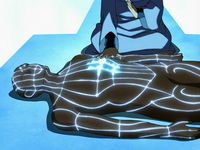
Healing is an example of the scientific knowledge of the Water Tribe.
Waterbending can be utilized to heal wounds, such as lacerations and burns, ease sickness brought on by pollution, alleviate mental illness, as well as improve the general flow of chi around the body.[9] This ability has allowed the Water Tribes to develop a strong base in medical science, as anatomical knowledge and an understanding of chi paths are necessary for healing.[12] The tribes also boast numerous schools that serve to train aspiring healers. This medical knowledge can also be used in ways that do not involve waterbending, such as yoga to improve chi flow.[13]
Herbal remedies, concoctions, powders, tinctures, and other techniques are also used to treat illnesses and spiritual ailments.[14] A rubbing paste of blubber and pepper berries is used to treat colds in the Southern Water Tribe.[15] During the era of Roku, the Foggy Swamp tribespeople foraged alchemical herbs to turn them into healing balms.[1]
Metallurgy and other crafts[]
Although the Water Tribes' utilize metal implements fairly regularly, their knowledge of metallurgy remains somewhat primitive compared to other nations. While it is unclear if they can forge their own metal or trade in order to acquire the metal that they possess, they are talented at working wood and bone, as many of their tools and weapons consist of those materials. The male members of the tribes also use these crafting talents to create betrothal necklaces.
Earth Kingdom[]
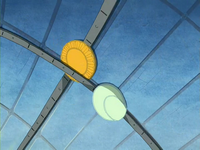
The planetary calendar room is one of the many scientific studies of the Earth Kingdom.
The Earth Kingdom is one of the most scientifically advanced nations in the world: Prior to the founding United Republic of Nations, it was second only to the Fire Nation in technological development. Due to the Earth's Kingdom's vast size, varying population density, and diverse people, the level of development is not uniform across the entire nation; in general, urban locations tend to have a greater preponderance of science and technology than the more rural areas.
Following Toph Beifong's discovery of metalbending at the end of the Hundred Year War, many new possibilities were opened up for technological development. While such innovations - and metalbending itself - are also not uniformly spread across the Earth Kingdom, they allowed many existing forms of technology to be updated and improved.
Anthropology[]
Ba Sing Se University has an anthropology department, once headed by Professor Zei. In addition to teaching a class on desert cultures,[16] Zei claimed to have discovered lost civilizations all over the Earth Kingdom and even journeyed into the Si Wong Desert to better understand the Si Wong tribes.[8]
Astronomy[]
Although not constructed by Earth Kingdom citizens, the planetary calendar room located in Wan Shi Tong's Library was a marvel of astronomical and mechanical engineering. By manipulating various dials on a central control panel, one can determine the position of the sun, moon, and stars on any given date.[8]
Medicine[]

Wood frogs are used for medicinal purposes.
The Earth Kingdom has a considerable degree of medical knowledge. Doctors, herbalists, and spiritual healers employ over a hundred unique herbs and tinctures to treat a variety of ailments from baldness to fever.[17][18][19] Medicinal plants are widely used to treat disease, stabilize wounds, and numb pain,[20] often being made into herbal tea, and massage therapy is utilized due to its beneficial qualities. Other concoctions with more bitter tastes can be used in tandem with waterbending healing to treat burns.[21] Salves and ointments are used as well to cure rashes, such as when Iroh was poisoned by the white jade bush.[22] Some practices aim to improve the patient's chi flow as well as treat a wide variety of diseases. Two such practices are acupuncture, which involves inserting fine needles into specific points to relieve pain,[13][23] and fire cupping, which relieves stagnant chi by placing heated glass bowls over the acupuncture points to draw out malignant energy.[22]
Surgery is practiced in the Earth Kingdom too, and doctors can be found in all larger cities, as well as in many smaller towns, and with military units. However, by 296 BG, the most skilled doctors were in such high demand that they were more likely to be found inside the walls of elaborate manors than in small towns.[21] The Earth Kingdom has many physicians, who study and treat numerous physical ailments, as well as herbalists, who devote themselves to the study and cultivation of medicinal plants such as sandalwood, banana leaf, and ginger root. Animal products such as frozen wood frogs are sometimes used in traditional Earth Kingdom medicine,[24] and red-hot irons are sometimes used to cauterize wounds resulting from severed limbs.[25]
Other advancements[]
In the field of engineering and technology, the mechanist had made many useful and important inventions. The mechanist used scientific knowledge, such as physics, in his inventions. He had a vast knowledge of mechanical science, making him a great advantage to the Earth Kingdom forces during the Hundred Year War. After the Great War ended, Ume was another creative inventor and architect from the Earth Kingdom who aspired to transform her nation with her inventions.[26]
Zoology[]
The head zoologists at Ba Sing Se University were charged with going out and fetching rare creatures for Earth King Kuei's private menagerie,[27] including a mate for Bosco, although one was never found.[28]
Fire Nation[]
The Fire Nation was the most scientifically advanced nation during the Hundred Year War.
Astronomy[]
The Fire Nation has a reasonable knowledge of astronomy, predicting the arrival of Sozin's Comet. They use this knowledge to tap into the power that can be gained when a comet passes close enough to the planet.
Botany[]
Certain Fire Nation citizens have demonstrated levels of botanical knowledge. Ursa's mother was a master herbalist and passed the knowledge onto her daughter, Ursa, who used this knowledge to craft a deadly poison that allowed Ozai to murder his father and take the throne in exchange for sparing Zuko's life.[29]
Chemistry and energy sources[]
The Fire Nation also has some knowledge in chemistry, having the ability to manufacture explosive weapons, which are used in fireworks. They also have some knowledge about mineralogy and fossil fuels, due to the fact that the Fire Nation Navy operates ships powered by coal, a burnable mineral.
Engineering and metallurgy[]
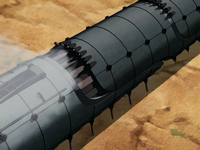
The Fire Nation drill is a feat of scientific ingenuity.
Metallurgy is the most advanced science in the Fire Nation, and during the Hundred Year War, this provided them with a key advantage over the other nations. It allowed for the creation of superior quality weapons and, combined with sophisticated engineering skills, modes of transportation, such as battleships, tanks, and innovative devices like the drill.[30] This technological edge gave the Fire Nation a particular advantage over the Earth Kingdom, as earthbenders were unable to bend refined metal. However, this advantage was lost when Toph Beifong discovered the art of metalbending and passed it on to other earthbenders who showed potential, eventually making the skill widespread.[31] The war effort increased the turnout of metal producing sciences. Factories, such as the one by Jang Hui village, specialized in the creation of metal weaponry.[32]
Geography[]
The Fire Nation also has moderate geographic knowledge. In Zhao's harbor, a painted map of the world is placed, which indicates the study and knowledge of the physical forms of the continents and territories. The Fire Nation also understands the geographical areas of the other nations, such as the Earth Kingdom, and the Water Tribes due to their fighting in the War.
Medicine[]
The Fire Nation has considerable medical knowledge. Places that treat mental health patients, such as the one Azula was taken to after the Comet-Enhanced Agni Kai, are examples of medical housing. As in the Earth Kingdom, people also know the health benefits of tea and relaxing yoga in hot springs.
United Republic of Nations[]
Architecture[]
As a result of their unique architecture and advanced knowledge in metalworking, the United Republic has made great strides in building construction. The country's wealth of resources has allowed them to develop the skyscraper, a structure that extends vertically instead of the more conventional horizontal style. These towers are quite tall, and rise high above the remainder of the city's buildings. Much unlike the region's traditional styles, skyscrapers have a spire-like design, bearing a pointed peak at the top. This tower has radically changed the layout of the metropolis and even revolutionized the economy, as businesses and facilities now consume less ground space, which has allowed more room for the continued construction of economic industries.
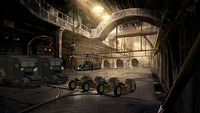
A typical underground Equalist facility within the tunnel network showcases advancements in underground construction.
In accordance with the region's geography, the United Republic has also developed the suspension bridge. These structures are found over waterways all throughout Republic City and allow for greater ease of transportation when using vehicles. All bridges have a characteristic arch, an architectural feat that represents the tremendous scientific development Republic City has undergone.
Another scientific landmark is the expansive tunnel network that snakes underneath Republic City. The city's advanced construction technology allowed for such a system to be created, and it even has transportation facilities such as a tram network as well as a garage for trucks and motorcycles.
Medicine[]
By 128 AG, medical science had improved greatly. In order to create a new identity after escaping prison, Yakone underwent a crude version of plastic surgery to alter his appearance, suggesting several medical breakthroughs and discoveries had been made since the end of the War.[33][34]
Metallurgy[]
Even prior to the official founding of the United Republic, this region showed significant advances in metallurgical technology: Yu Dao, the oldest Fire Nation colony in the Earth Kingdom, produced the finest metalwork in the world by 101 AG through the combined efforts of Fire Nation colonists and Earth Kingdom residents.[35]
Prior to 128 AG, metalworking was advanced enough to create uniforms and wires for the Republic City Police, allowing the Metalbending Police Force to quickly move around Republic City.[36]
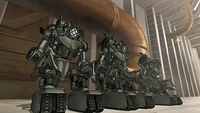
Mecha tanks were developed by Hiroshi Sato in 170 AG.
By 138 AG, metallurgical advancements had developed enough to allow for the manufacturing of cars.[37]
By 170 AG, the knowledge of metallurgy had advanced to the point where mecha tanks could be made from platinum and were able to be infused with the necessary electronics that would allow one to control it from the inside.[38]
Other advancements[]
The general knowledge of physics has developed greatly to the point where radiation and sound waves were no longer a mystery.[7]